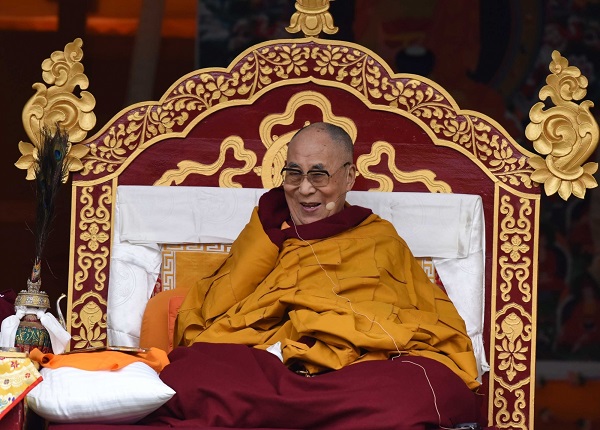Dharamsala, Eighty-four and still young!
Revered by the Tibetans as a ‘living god’ and idolised in the Orient and the West, he transcends all barriers of religion, language and even distances.
Wearing his trademark maroon robes, he stepped out of politics almost eight years now, but is active like never before in his sermons across the globe — a global citizen.
As the world celebrated his 84th birthday in July, IANS looks at future plans of globe-trotting Tibetan spiritual leader, the Dalai Lama — the global face of the Tibetan exile movement, who rubs shoulders with leaders of the world — his contributions, his yearnings, the Tibetans without him, who is the next Dalai Lama after him, his vision and his love for India.
His commitments:
Promoting human values, non-violence and religious harmony, say aides of the Dalai Lama.
The elderly monk, known for his simplicity and typical jovial style, prefers to participate in meetings with religious leaders, and lectures businessmen on ethics for the new millennium and the art of happiness.
He chuckles throughout his talks and often slaps visitors on their back.
“His Holiness the Dalai Lama plans visits only on the invitation of institutions and organisations. He prefers visiting universities and educational institutions to speak on peace, non-violence and promoting human values,” Tenzin Taklha, joint secretary at the Dalai Lama’s office, told IANS.
The spiritual leader has met all the US Presidents since George Bush (1991), except Donald Trump. He has met Bill Clinton and George W. Bush several times.
His contributions:
“His Holiness attaches great importance to educating Tibetan children. Whenever, wherever he gets an opportunity, he loves to interact with them. He wants to make them bold enough to face the world,” Thubten Samphel, director of the Tibet Policy Institute, a think-tank under the Central Tibetan Administration (CTA), told IANS.
His yearnings:
Living in exile in India for over half a century, the longing to see his homeland is still fresh in the mind of the Dalai Lama.
“Yes, I remain optimistic that I will be able to return to Tibet. China is in the process of changing,” the Dalai Lama wrote on his website (dalailama.com).
The Tibetans without the Dalai Lama:
“One day you will hear that the Dalai Lama has passed away, but I will come back, even if the institution of Dalai Lama is no longer recognised. I will be back,” says the Dalai Lama.
But Lobsang Sangay, the first democratically elected Prime Minister of the Tibetan government-in-exile, believes the Tibetan movement will remain strong as it ever was.
“We do believe in the middle-way approach that international leaders and even many Chinese intellectuals support,” he said. “As long as human rights violations continue, there will be resistance from our people in Tibet.”
“I hope China will accept dialogue as the only way to resolve the issue peacefully,” Sangay, whose post has acquired added stature with the Dalai Lama stepping down from diplomacy and politics in 2011, told IANS.
The 49-year-old Sangay took over the reins of the government-in-exile in August 2011 from monk and scholar Samdhong Rinpoche, who held the post for 10 years but was overshadowed by the Dalai Lama.
But who is next after the Dalai Lama?
“If useful, my successor could be female,” says the Dalai Lama.
But at the same time, he said, whether “the institution of the Dalai Lama remains or not depends entirely on the wishes of the Tibetan people. It is for them to decide”.
“If I were to die today, I think the Tibetan people would choose to have another Dalai Lama. Personally, I feel the institution of the Dalai Lama has served its purpose.”
He considers himself a son of India:
“All particles in my mind contain thoughts from Nalanda. And it’s Indian ‘dal’ and ‘chapati’ that has built this body. I am mentally and physically a son of India,” the Dalai Lama in his addresses is often quoted as saying.
“India and Tibet share a relationship of ‘guru’ (teacher) and ‘chela’ (disciple). When I see some part of my ‘guru’ being corrupt, as a ‘chela’ I feel ashamed.”
Time and again, a demand from Indian parliamentarians and his believers is being raised that India should confer its highest civilian award — Bharat Ratna — on him in recognition of his services to humanity.
His vision:
Although not tech-savvy, the Dalai Lama is quite a hit on social media sites Twitter and Facebook.
The monk has been advising the Tibetans to reach out to Chinese people. “If they knew more about our ‘middle-way approach’, a majority of the Chinese people would support us.”
His office says the Chinese scholars from Taiwan and mainland China are regularly interacting with the spiritual leader on Facebook posts. It also helps understanding his ‘middle-way’ policy for Tibet.
Staunch believer of the ‘middle-path’ policy that demands greater autonomy for his people while accepting Beijing’s sovereignty, the spiritual leader is viewed by the Chinese as a “traitor” who is bent on splitting Tibet from China.
In 1959, the occupying Chinese troops suppressed the Tibetan national uprising in Lhasa and forced the Dalai Lama and over 80,000 Tibetans into exile in India and neighbouring countries.
On reaching India after a three-week-long treacherous journey, the Dalai Lama first took up residence for about a year in Mussoorie in Uttarakhand.
On March 10, 1960 just before moving to Dharamsala, which also serves as the headquarters of the exiled Tibetan establishment, the Dalai Lama said: “For those of us in exile, I said that our priority must be resettlement and the continuity of our cultural traditions. We, Tibetans, would eventually prevail in regaining freedom for Tibet.”
Currently, India is home to around 100,000 Tibetans and the government-in-exile, which has never won recognition from any country.










